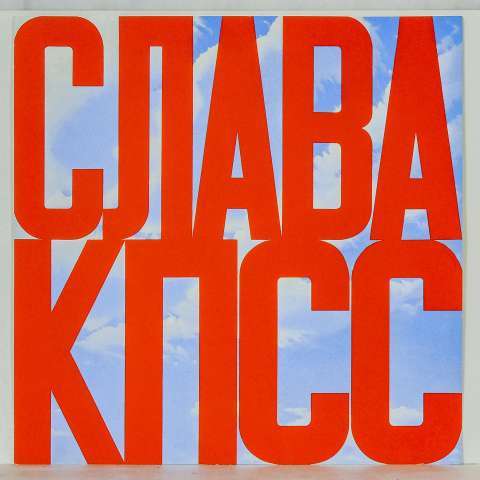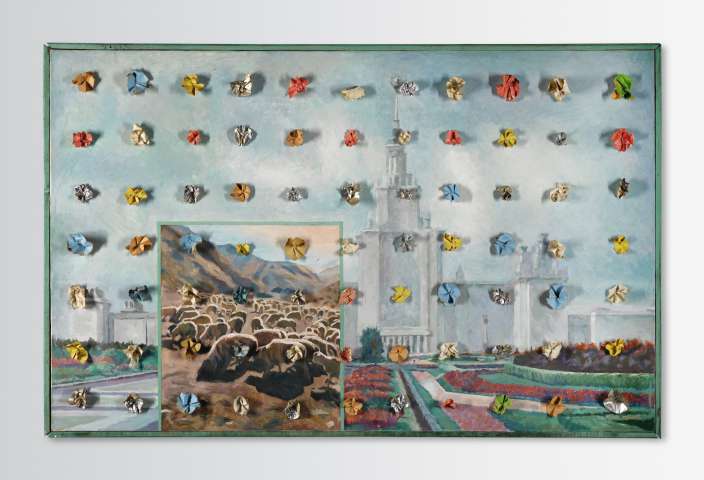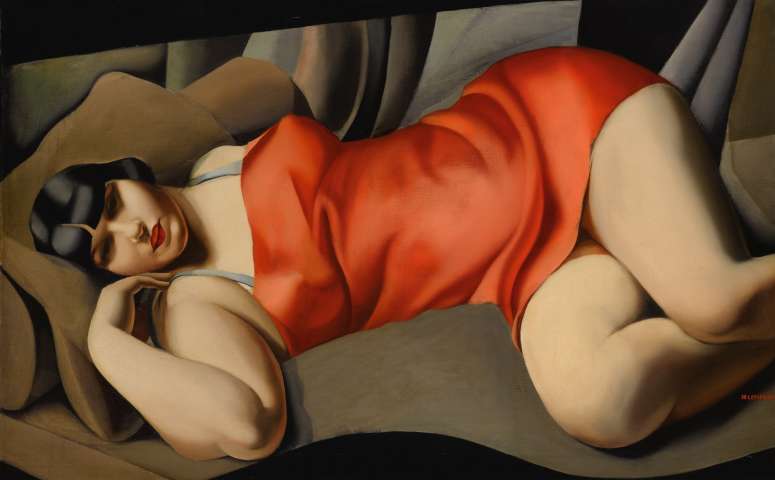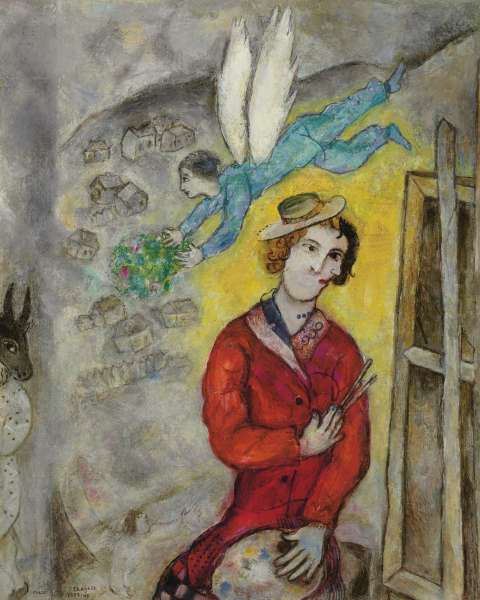
According to unofficial statistics, in 2019, sales of paintings, drawings and sculptures at auctions in Russia amounted to $9.9 million, which is 53% less than in the pre-crisis 2013. But 47% more than in 2018. How to interpret this result?
— You see! — they will say. Life is getting better! And it’s impossible to listen, just whining around.
— Oh, come on! — others will say. The results are drawn like everything else. Look at the economy. Why would you suddenly expect one and a half times the growth in the art market?
Something is wrong here. The result is abnormal. We need to further investigate, we thought.
And when we looked more closely, it turned out that the first and second were right. Ask how is this possible? That's how.
It is no secret that auctions really voluntarily or involuntarily embellish sales statistics. Sometimes this is done for advertising purposes: the better the percentage of sales, the more they bring to the auction. And sometimes distortions arise in cases of non-redemption of lots. There are situations when money has not arrived from the buyer, the lot has not been paid, but sales data has already been recorded by statistics. On the other hand, real post-auction sales in databases are almost never taken into account. That is, plus or minus these differences are balanced.
At the same time, everyone understands that it is impossible to keep track of everything. Statistical distortions were always there. In addition, accuracy to the ruble is not needed here. The main thing is to understand the general trend. And it worked fine year after year. But it seems that according to the results of 2019, for the first time, one will have to resort to manual adjustment. And refuse to recognize the statistical amount of sales in favor of expert judgment.
Why?
In the data on sales of Moscow auctions for 2019, there are two outliers. This is not a curse. In statistics, this word refers to a result that is strongly out of the general row. For one house auction, the sales volume had to be supplemented manually, since it does not publish the results of fairly successful budget tenders. And the second, on the contrary, published prices for lots that did not reach reserves (that is, unsold). What made the confusion not only in mathematics, but also in the plans of the deliverers. Because of this, at first glance an innocuous reception, it turned out that one auction per year not only increased sales four times, but also captured almost 70% of the Moscow auction market for fine art. Now, for the objectivity of the picture, these figures will also have to be adjusted manually.
And then what will happen to us in terms of turnover in 2019? You will be surprised. About $7 million, maybe a little more. That is, as in the year before last 2018. According to our estimates, such is the more or less real sales volume of the auction market in Russia last year. According to the results of 2019, the turnover of the gallery market amounted to about $30 million (the figure is also in the expert evaluation mode).
There are two ways out of here. First: yes, the sales situation has not worsened compared to last year. Even improved a little. The second conclusion: sales growth marked by statistics as almost one and a half times more likely to be qualified as a measurement error. Moreover, the fundamental factors for this growth cannot be detected.
We write and marvel at ourselves. Bet about 7 or 10. What a scale! The size of the original base is still ridiculous. But we are talking about the auction art market of the country with a population of 147 million people. Moreover, a country with rich cultural traditions, with a significant contribution to world art, and also experiencing a boom in cultural tourism. That is, on the one hand, there are kilometer queues in museums, and, on the other hand, 17 auction houses throughout the country. Of these, 14 are in Moscow. And the debate is about 7 or 10 million turnover.
The field is not plowed. Work and work.

What about Russian art at auctions in the world? And by the world we mean Sotheby's, Christie's, Bonhams, as well as French and German auctions, which often sell former Russian artists. Formally (statistically) for the year, the sales of Russian art fell from $523 to $398 million. At the same time, the percentage of sales remained the same — around 50%. What is this talking about? About the fall? Not. Only that the size of the Russian art market abroad is also relatively small and therefore very sensitive to unit sales of masterpieces. Relatively speaking, one Malevich for $85 million immediately makes a third of the annual “box office”. In 2018, there was such a Malevich, but in 2019 it did not happen. And if there had not been such champions as Rothko for $50 million and de Stael for $22 million, the turnover would have fallen to $326 million altogether. That’s the whole explanation. So it didn’t get worse in 2019. Quite the contrary. So, according to the results of the Russian autumn auctions, we observed that masterpieces from bins again appeared at first-class auctions. Obviously, collectors and investors agreed to new lower prices, stopped waiting forever for better times. As a result, we received normal demand and concluded successful deals on good conditions. What is welcome.

The unconditional «driver» of the Russian art market in the world in the past year was Marc Chagall. No, formally Rothko was again in the first place in terms of turnover. Of the six of his works exhibited, all six were sold for a total of $106 million (Rothko's sales represent a quarter of the Russian art market). But this is a phenomenon. It must be considered separately. But Chagall is the real “blood” of the Russian market abroad. He is a leader in liquidity. His 346 sold out of 486 exhibited works brought to the treasury of Russian art almost $70 million. Moreover, individual transactions with the works of Chagall became an exemplary example of investment in art last year. Although there aren’t any stunning figures in percent per annum, these are all clear and believable options in money. For example, a self-portrait, bought at Sotheby's in 2000 for $1,100,000, was resold at Christie's for $1,935,000 in the past 2019. Each year, the previous owner earned an average of $42,000 on it. And there were such stories with Chagall quite a lot.

In general, for the year we can note a good conjuncture for Pavel Chelishchev, Nicolas de Stael and Tamara de Lempicka (though this is also unit sales). As always, Vasily Kandinsky and his friend Alexei von Yavlensky, “Russian Parisian” Serge Poliakoff, “our everything” Ivan Aivazovsky sold well. And the miracles of liquidity and investment attractiveness in recent years have been demonstrated by the work of Louise Nevelson, also our artist, about whom few have heard in Russia.
But back to the domestic market, where there is neither Louise Nevelson, nor the universally recognized expertise on Chagall.
What was in demand with us?
If we talk only about auctions and set aside private transactions, the leaders of liquidity remained the first names of unofficial post-war art. You know them perfectly: Anatoly Zverev, Vladimir Nemukhin, Oscar Rabin, Evgeny Kropivnitsky and others. And also Natalia Nesterova, Kim Britov, Nikolai Ossovsky. Quite successfully in the past year, Russian classics were sold — the 19th century. Demands were in names, pictures of small sizes for relatively little money. Malyavin, Aivazovsky, Savrasov, Levitan. Large formats dealers are still saving for closed private transactions, while small and inexpensive ones were well sold out at public auctions.
What can be said about buying activity in the domestic market?
According to statistics, the share of lots sold increased from 45% to 49%. But, obviously, this figure was affected by the same emissions that distorted the overall auction turnover. In expert evaluation mode, I would say that purchasing activity also remained at the level of last year. No worse, no better. That is, all who sold more than 45% of the lots — well done.
What are the positive results of the year? What was good?
- The “CHA crisis” was resolved. The months-long period of uncertainty has ended. Tenants successfully relocated and joined the work. A significant part of the galleries from Krymsky Val received a good rental offer and moved to Gostiny Dvor, where in the future an art quarter with a unified navigation system will be formed. In the Gostiny Dvor, an Antique Salon is now also held. That is, in general, the situation has stabilized.
- The number of auction houses has not decreased. Someone has increased activity, someone has reduced. But nobody closed in a year. On the contrary, on December 1, 2019, the first auction was held by the new auction house Pioner & Co. And on December 10, 2019 we summed up the results of the first auction of our new weekly auction ArtSale.info. So now in Moscow there are 14 art auctions (if Litfund and the ArtLitfund are considered separately).
- Not a single truly “black swan” has arrived. So called an unpredictable event, bearing disastrous consequences. In particular, the luxury tax was not introduced last year, conversations about licensing antiquarian activity subsided, and economists did not expect “oil at $40 and 70 rubles per dollar”. That which did not get worse is good news.
Negative trends of 2019?
- Once again, opportunities were missed to adjust legislation and improve the business environment in the art market. Market participants received neither export support, nor justice and transparency in the application of the right to follow. Among the additional problems, one can add a tightening of bank policies to the business of transferring money to individuals (both from collectors-buyers and collectors-sellers). Banks operate under state pressure, which creates absurd difficulties for the legal auction and gallery business. Instead of stimulating its development and openness. It is clear that all this could already be corrected 10 times and done wisely. But in the end, another year in this sense was wasted.
- In the domestic auction market, quality supply was declining. And declined markedly. Less auctions began to offer liquid works for sale. The trend, in principle, is not new. But the past year has somehow exposed it more strongly. Our explanation for what is increased competition between auction houses. The choice of the vendors has become more. People try, make mistakes, try again. So the process is more likely objective, and participants should not try on it only for themselves.
- 2019 was the year of bad news and bad signals for private museums and private gatherings. The collection of the Ananyev brothers was arrested, which ultimately led to the closure of the Institute of Russian Realistic Art — the best private museum in Russia. The confiscated collection of the International Confederation of Unions of Artists Masut Fatkulin was distributed by the Ministry of Culture to regional museums. Pictures from the collection of Jeanne Bullock and the former Minister of Finance of the Moscow Region were also distributed among museums. The reasons are different. But the result is one: dozens of masterpieces and hundreds of important works were forever removed from the market. Contrary to logic, they did not sell them at auction to compensate for the damage, but sent them to state museums.
- There was a deterioration in the situation of Russian artists. In particular, after the alienation of the Central House of Artists, Moscow painters, graphic artists and sculptors never had an alternative platform with a “gravity” of viewer buyers, where the artists themselves could arrange exhibitions for little money. How artists can do it now — only God knows. And in general, the past year was remembered by a whole series of episodes of pressure on artists by the authorities (sometimes under the guise of the public). This also includes laying asphalt on the “Suprematist Cross” of Pokras Lampas in Yekaterinburg (as a result, the artist agreed to redo the concept). In Moscow, the author’s street paintings were destroyed and the rules were introduced to coordinate graffiti with the «artistic council» of city authorities. And in the same row you can put the eviction of artists from Moscow workshops. It seems that the events are not directly related, but lie in a single logic. With artists, if they were not in a privileged cage, last year they did not stand on ceremony.
So what goes into the circle? The year was not easy. But with all the problems, 2019 will most likely be remembered by us as not the worst year of the era of stagnation. An ineffective and hypocritical economic policy reliably keeps the Russian art market on the periphery of the world, does not allow the art business for explosive growth. On the other hand, the state in 2019 did not take new pronounced repressive steps against participants in the art market. What is already fit to rejoice.
And indeed life always takes its toll. Even in poor conditions, everything is somehow developing. Paintings are being sold. Little by little new customers are emerging. A lot is starting to come out or is already coming out. In certain areas, in certain segments, even the intensification of economic activity arises. It is clear that this is happening rather contrary to — due to the adaptation of market participants and customers to new conditions. Not at the expense of some expectations of a brighter future. And, on the contrary, in the mode of final sobering up. Hopes for better times have already passed. And there was an understanding that the art business is what is happening here and now. A decision on the sale must be made at current prices and in the current market situation.
So it was a good year. There will be something to remember.
But what to expect in 2020? What, for example, will be with the prices? Most likely, 2020 will be the next “year of the buyer”. In general, the price trend is likely to decline. But the decline is not uniform for everything. In the budget and middle segments, prices will fall. And on the upscale expensive works and masterpieces, prices will, on the contrary, rise. So the advice for this year will be straightforward. Who was going to sell — sell. Who was going to buy — buy. It makes no sense to guess and put off.
Vladimir Bogdanov, ASi
Additionally:
VIDEO. Konstantin Babulin on the results of 2019
- Log in to post comments










